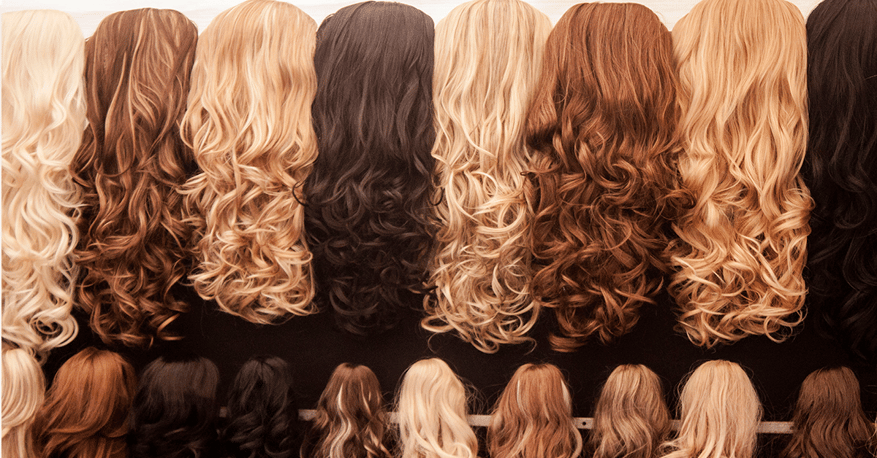By Jeff Waite on Nov 13, 2017 2:39:28 PM

Nowadays, hair systems and hair extensions are used world-wide. A large percentage of models, actors and actresses use them all the time. However, it hasn’t always been like that. So, when did they become such a trend? How are they made? Where does all that human hair used in hair systems come from, anyway? Believe it or not, there are a bunch of weird facts about wigs out there that even hair system users have no clue about! Here are some of them:
1) Where does the name come from?
Wig is the diminutive for ‘periwig’, which came into the English Language in the late XVII century. According to linguistic specialists, it is believed that the word’s etymology comes from a corruption of the French term perruque, commonly called “the peruke”. Periwigs were an essential part of British and French high-class household styles. It also contributed to keeping some type of hygienic standard. To learn more on the history of wigs, feel free to read our blogpost on that topic.
2) Is it true that wigs were more popular amongst men than amongst women?
It may be hard to believe, but at a certain point in history more men wore wigs than women. After King Louis XIII started using a wig and set a trend which was shortly followed by other male monarchs, wigs started becoming popular amongst the upper-class in France and England back in the 18th century. Eventually, wigs became the tradition of certain professions (mostly judges and some high-public charges; as well as theatre costumes) which enforced the use of a wig (and is still continued in countries today). On the other hand, women would only use wigs to dress certain styles whenever they left the house. Wigs would not become more popular in women than in men until the 1950s.

3) Where does all the hair used in hair system production come from?
India and China. Many people in these countries shave their heads in traditional religious ceremonies. There is a local temple in India, in the town of Tirumala, that receives hair donations from at least 20,000 devotees each day. There are 600 employed barbers working there to get the job done. And that’s only one temple. Besides, in India up to 25% of the 40 million pilgrims per year shave their heads. Temples sell all the hair they receive to wig producers to then help with charitable endeavours. However, this only accounts for 20% of the hair coming from India.
The hair business is huge, (most of its demand comes from the western world, with the US as its epicenter) lucrative (more than 2 billion USD every year) and sometimes corrupt and inhumane. Hair is worth a lot of money: Temples usually sell it for 700 USD a pound and wigs go all the way up to 8,000 USD! Synthetic wigs might be worth around 300 USD, but a real human hair wig averages 1,500 USD. The hair business does not only include wigs, it also includes items like false eyelashes, industrial by-products like fertilizers, stuffing for clothing, and even for the production of certain amino acids. The remaining 80% of the hair in India basically could come from anywhere - all the way from barber shops and salons, to waste pickers who gather it from trash and dumpsters. Hair traders will even go to villages and barter with women for hair. Sadly, hair is not always sold or gathered willingly - some women are forced by their families to shave their heads, and others are kept as prisoners. Hair is often referred to as black gold in India given its tragic nature.
4) How are wigs made?
The first step is quite obvious: hair needs to be acquired. It is then sorted out by length, hair direction and by how tangled it is. Next, the hair is washed and dried, and then dyed in different colors. It is then either made into a wig, or shipped out to salons to be sewed, taped, or bonded as extensions - the process could take up to several days. On the other hand, a fully custom-made wig could take up to eight weeks to be fabricated. There are two main types of human hair wigs: the hand tied lace wig and the traditional machine stitched weft wig. The latter is the most popular and also the easiest to make, which ensures some degree of affordability. However, hand tied lace wigs are much more realistic (as it give the illusion that hair is growing from the scalp) but more expensive as well.
5) Hair Care is Vital
A human hair or custom hair system will definitely look and feel amazing, but it requires appropriate care, otherwise you won’t have it around for long. Human hair wigs need proper shampooing and conditioning, amongst other steps that you can read about on our blogpost on proper hair care. You can also check out Advent Hair’s selection on conditioners and shampoos which are amongst the most trusted in the market.

If you have any other question for us, feel free to give us a call at our toll-free number 1-800-756-8585. You are also welcome to check Advent Hair’s site for more information on hair systems. We’ll be more than happy to help you with any other burning questions or doubts you might have!







